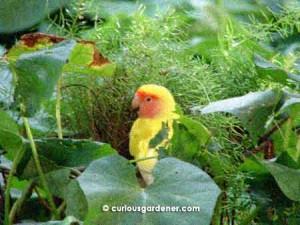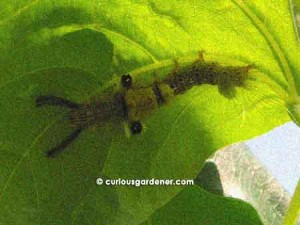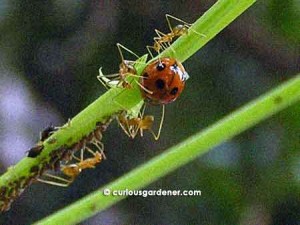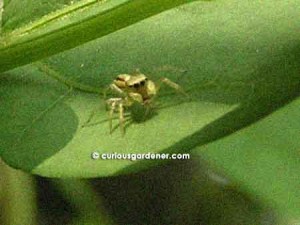I honestly don’t know what it is about our sweet potato patch. It’s like a magnet for unusual birds, if you ask me. The latest avian visitor was spotted this morning, literally right in the middle of the sweet potato patch – easy to see because it was bright yellow amidst all that greenery.
I have to admit that the sweet potato vines have gone pretty wild. They initially provided ground cover under our old mango tree, but then they got more bold and have been growing over potted plants that were also enjoying the dappled shade, going to the extent of climbing up plant stands and, if allowed to, smothering the plants there. So within that sea of leaves are some pretty big pots that are hidden, with their plants barely visible. And within the bushy foliage of a potted asparagus fern was this little feathered creature…
What an amazing shade of yellow it was! And with such intriguing shades of peachy-orange around the face. My guesstimate at its size is about 15 cm high. We looked at each other for a while until I determined it wasn’t terrified of me, about 6 metres away from it, inside the house. Then I got the camera and started taking pictures carefully. It just sat there for a while, perched on, probably, the rim of the wire pot stand that the fern is on. After looking around, to my delight, it began feeding on the sweet potato leaves, stretching its neck up to grab the edges of the leaves and ripping pieces off. From time to time, it would make little tweets. Guess it was enjoying itself!
After perhaps 20-30 minutes of feeding, it flew up to my neighbour’s lipstick palm tree where it chose to perch on a dried branch and, I assume, clean or sharpen its beak. I’m not an expert on birds – I’m guessing that’s what it was doing! It was there for at least 10-15 minutes, tweeting from time to time.
Satisfied that I’d taken some decent photos, I next turned to some friends and the Internet to try to find out what the bird was. My first assumption was some kind of parakeet. However, the closest match my friend found was the Lutino Rosy-faced Lovebird. Now, I doubt it’s a native to Singapore, so it’s probably an escapee from somewhere. It also didn’t appear troubled by people, so it might have been domesticated. Perhaps a bird expert can provide some enlightenment on this?
© 2011 curiousgardener.com All rights reserved.
















